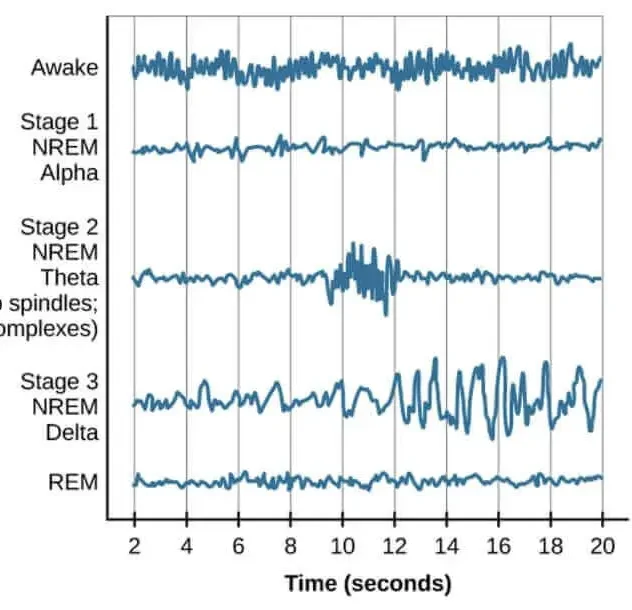If you’re familiar with sleep, you’ve probably heard of sleep cycle.
Our sleep is composed of several sleep cycles each night. Generally each sleep cycle include three non-rapid eye movement (NREM) stages (N1, N2, N3) and a rapid eye movement (REM) stage.
Non-REM and REM Sleep
Non-REM sleep can be divided into 3 distinct sleep stages: Non-REM stages 1-3 (N1, N2, and N3), with the depth of sleep increasing as the numbers go up.
Thus, stages 3 are the deepest levels of Non-REM sleep, where “depth” is defined by how hard it is to wake someone up. It’s more difficult to wake someone during stage 3 than in stage 1 or 2.
REM sleep, on the other hand, is generally associated with dreaming.At the end of the REM stage, we wake up. But we usually don’t remember these awakenings and move on to the next sleep cycle.
What are the 5 Stages of Sleep Cycle?
Human brain activity can be split into 5 states: Awake, Non-REM (N1,N2,N3) and REM. Studies show that brain waves detected in these three states are different, reflecting varied brain activities and functions.

• Awake: During wakefulness, brainwaves are active, irregular, of high frequency, and the brain processes various external information, which is considered to be “receiving” information.
• Non-REM (N1,N2,N3): In this sleep stage, sleep brain waves move smoothly at a low frequency in a specific direction, including spindle waves which help block external disruptions, making it hard to wake from sleep.
This sleep stage primarily functions in transferring information from short-term to long-term storage.
• REM: Waves in REM sleep resemble those of the awake state—high frequency, chaotic, irregular.
This is the dreaming phase, and studies indicate some brain regions are even more active than when awake.
One cannot distinguish between being awake and being in a REM state by brainwaves alone; it’s necessary to check for two other factors: eye movement and zero muscle tension.
The function of the REM stage is to reorganize and link information, not from the external environment, but stored information from past and present in the brain.
How Does Sleep Cycle Work
Hypnogram shown below is a sleep stage graph throughout the nightSleep Stage Graph.

Our brains complete a sleep cycle approximately every 90 minutes, undergoing roughly 4-6 sleep cycles per night.
However, within each 90-minute period, the ratio of Non-REM to REM sleep shifts significantly. Non-REM sleep stage dominates the first half of the night with little REM while REM sleep takes dominance in the latter half.
Factors Affecting Sleep Cycles
1. Environmental factors:
Light, noise, and room temperature can significantly impact sleep cycle.
For instance, excessive light can suppress the production of melatonin, delaying the onset of sleep.
Noise is another factor to disrupt sleep, while a suitable room temperature helps the body enter deep sleep more quickly.
2. Psychological factors:
Mental state plays a crucial role in sleep. Stress and anxiety can cause insomnia, affecting the proportion of deep sleep and thus sleep quality.
3. Behavioral habits:
Lifestyle and daily routines are directly linked to sleep health. Late heavy meals, evening caffeine intake, and irregular schedules can disrupt normal sleep cycles.
Conclusion
Sleep is not merely a simple rest for the body but involves complex stages of Non-REM and REM, each having a profound impact on physical and mental health.
By improving factors that influence the sleep cycle, gaining a deeper understanding and making appropriate adjustments to one’s sleep pattern can lead to a healthier life and improved well-being.
